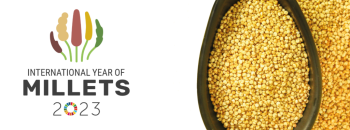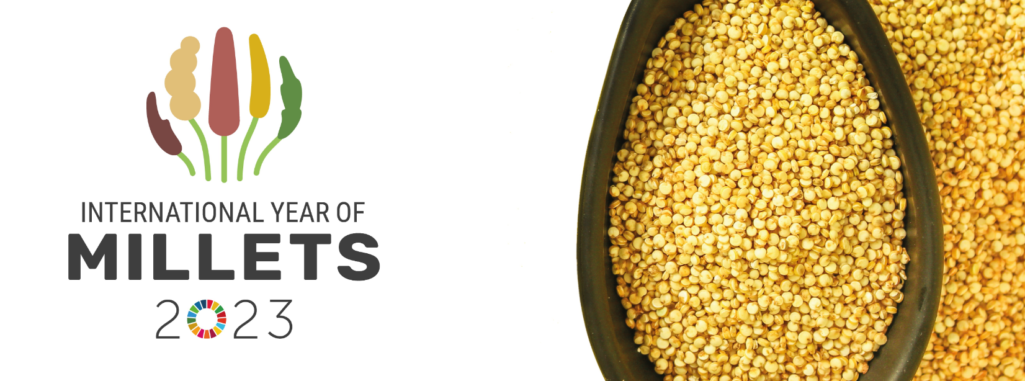
.jpg) J. Prasant Palakkappillil
J. Prasant Palakkappillil

An India Government initiative to observe 2023 as the year of millets was accepted by the UN. The subtitle goes thus: ‘Unleashing the potential of millets for well-being of people and the environment’. I would paraphrase it as: Millets for ONE Health – of people and of planet. As the global community moves towards the 2030 goals, though it might appear simplistic, I find focussing on millets can be one step closer to SDG (Sustainable Development Goal) 1 – no poverty; SDG 2 – zero hunger; SDG 3 – good health & well-being; SDG 11 – climate action; SDG 12 – sustainable consumption and production; and SDG 15 – life on land.
Millets are collective group of small seeded annual grasses that are grown as grain crops, primarily on marginal land in dry areas of temperate, sub-tropical and tropical regions.
Millets belong to the grass family, known for their edible small-seeds, rightly translated in Malayalam as 'cheru dhanyangal' (small cereals), whereas Hindi dictionaries give equivalents like 'jondhri' and 'mota anaj".
It formed the staple food for several millions in India and across the world, especially those living in arid and semi-arid regions. I made an effort to get a comprehensive list from various sources, and I have arrived at this:
Bajra (Pearl Millet)
Barri (Proso or Common Millet)
Choti Kangni (Browntop Millet)Jhanghora/Sanwa (Barnyard Millet)
Jowar (Sorghum) or Great Millet
Kangni/Kakum (Foxtail or Italian Millet)
Kodra (Kodo Millet)
Kutki/Shavan (Little Millet)
Ragi (Finger Millet)
Fonio (black and white) - one of the smallest grains, usually grown in West Africa.
Eragrostis Teff - a tiny Ethiopian grain, but rich in Calcium. The last two appear to be confined to African terrains, whereas, the rest of them are said to be available in India.
Some others listed are: amaranth millet (Rajgira), Buckwheat millet (Kuttu) etc.
Research in Millets
At Solapur, Maharashtra, under Indian Council for Agricultural Research (ICAR), Indian Institute of Millet Research (IIMR) has been established. The research over the years have led to the development of high yielding and hybrid varieties. But my fear is whether we will lose the original germplasms in the concern for producing more.
Research in ancillary technologies has led to developing machines that reduce the otherwise tedious task of extracting the edible part of the 'tiny nutrition balls'.
Millet Crop World-wide
97% of millet production (and perhaps, consumption as well) happens in developing countries indicative of its utility for the vulnerable sections, facing food and nourishment challenges.
Africa is the millet leader, producing 489 lakh tonnes from 423 lakh hectares, followed by Asia with 215 lakh tonnes from 163 lakh hectares. Though the US cultivates just 53 lakh ha, its productivity is almost equivalent to that of the whole of Asia -- 193 lakh tonnes! In India, production is concentrated in 6 states, viz., Haryana, Madhya Pradesh, Rajasthan, Andhra Pradesh, Karnataka and Maharashtra. While the world-wide productivity is 1229 kilos/ha, India is marginally better with 1239/kilos per hectare. (This is to be compared with the average productivity of wheat at around 4.5 tonnes per ha., and that of rice ranging from 3 to 6 tonnes per ha.)!
While production has shown a steady increase of 228% from the 1950s to 2020, there is a steady decline in the total area cultivated since green revolution by 56%. And millet share to the global food basket has shrunk to 6% from 20% of the pre-green revolution days.
A Means towards One Health
“Millets are incredible ancestral crops with high nutritional value. Millets can play an important role and contribute to our collective efforts to empower smallholder farmers, achieve sustainable development, eliminate hunger, adapt to climate change, promote biodiversity, and transform agrifood systems,” FAO Director-General QU Dongyu.
The attractions of this diverse crop varieties are their potential as a climate change resilient crop, requiring less water, which can grow in arid and semi-arid regions, lesser growth inputs when compared to the dominant crops like rice, wheat or maize and which needs and lesser duration. The high yielding varieties may require greater inputs, and now about 80 hybrid varieties are available in India.
Advantages: People's Health
• Gluten free grains
• Lower blood glucose response, making it a diabetes preventive food.
• It induces production of phase-2 detoxifying enzymes thus reducing cancer risk.
• Millets prevent the oxidation of low-density lipoproteins reducing lipase activity and hence hypertension occurrence.
• Nutri-cereals on account of the richer content of minerals, vitamins, anti-oxidants and fibre (detailed analysis in: https://millets.res.in/millets_info.php)
Advantages: Planet Health
• Dryland crop with greater crop duration
• Minimal water and other purchased input requirements (but responsive to higher inputs)
• Resilient to climate change (C4 plant) and an ideal contingent plant.
• Sustainable future food crop with multiple potentials -- food (nutritional security), fodder, forage, fuel (energy).
Challenge: As life-style diseases are on the increase, doctors have begun to recommend millets as a dietary substitute, and there is much more demand for this than before. When it comes processed and attractively packaged, with the increased health benefits, they are now found to be more expensive than the dominant foodgrains like wheat or rice. On the other hand, this increased income does not get shared with the basic and marginal farmers who are involved in its production. A solution to this has to be found.
Milleting our Lives in 2023
• Identifying and presenting 'millet kitchen' -- the various foods that can be prepared from millets. Local Millet Food Fests.
• Millet Expos -- Presenting, familiarising and storing various varieties of millets -- original and hybrid collections.
• Health benefits unique to each variety of millet could be identified and documented.
• Demo-plots by educational/religious institutions, voluntary development organisations and local government bodies.
• Agri(millet)-cooperatives for seed-banks, credits, storage, fair marketing and promoting organic production of millets. Preventive action against seed monopolies and genetic modification (GMO).
I have made my choice with inclusion of the attractive red Ragi (finger millets) in porridge/dosa/puttu forms in my regular diet beginning with January 1, 2023. How about you?